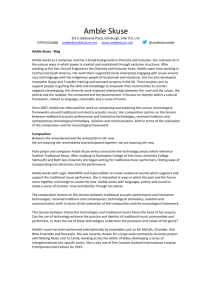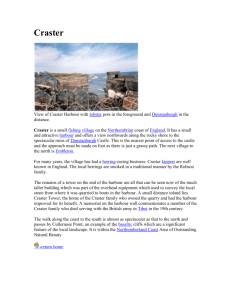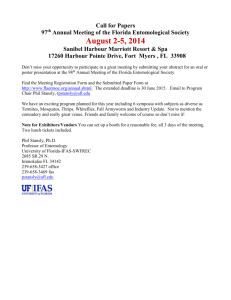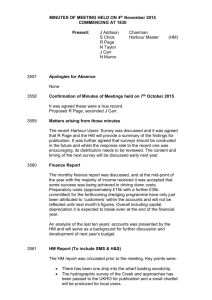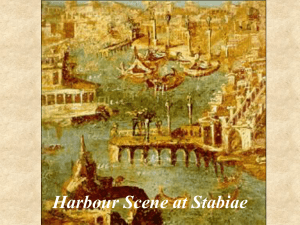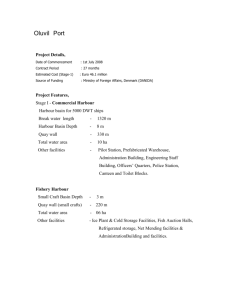however no one is quite sure who Anna was
advertisement
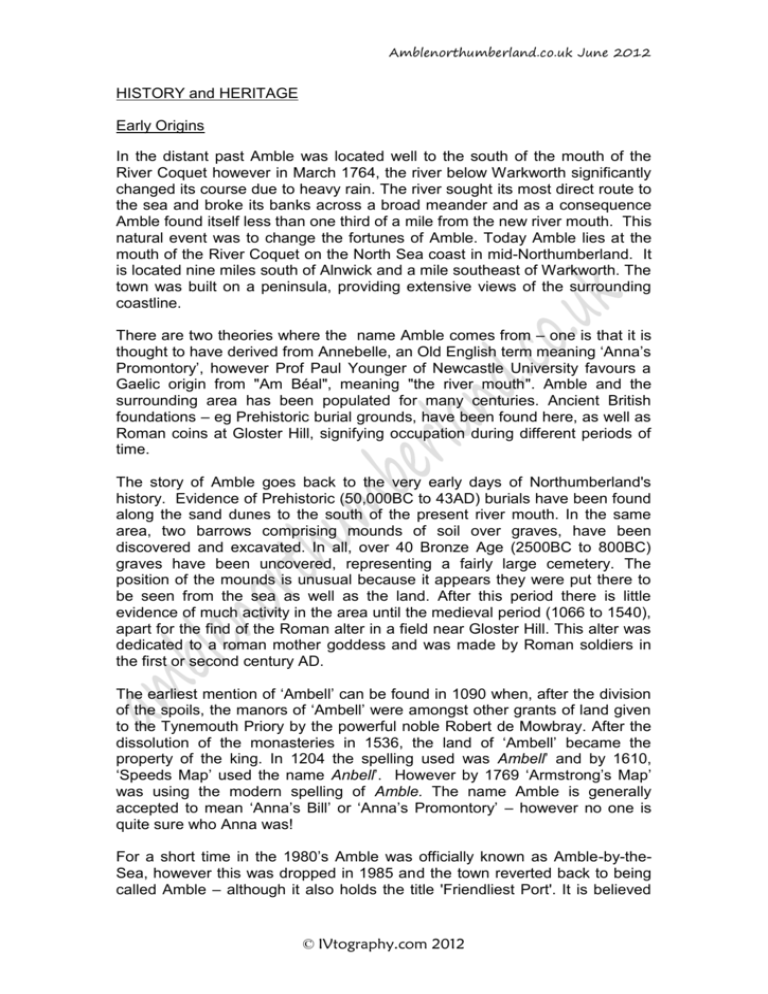
Amblenorthumberland.co.uk June 2012 HISTORY and HERITAGE Early Origins In the distant past Amble was located well to the south of the mouth of the River Coquet however in March 1764, the river below Warkworth significantly changed its course due to heavy rain. The river sought its most direct route to the sea and broke its banks across a broad meander and as a consequence Amble found itself less than one third of a mile from the new river mouth. This natural event was to change the fortunes of Amble. Today Amble lies at the mouth of the River Coquet on the North Sea coast in mid-Northumberland. It is located nine miles south of Alnwick and a mile southeast of Warkworth. The town was built on a peninsula, providing extensive views of the surrounding coastline. There are two theories where the name Amble comes from – one is that it is thought to have derived from Annebelle, an Old English term meaning ‘Anna’s Promontory’, however Prof Paul Younger of Newcastle University favours a Gaelic origin from "Am Béal", meaning "the river mouth". Amble and the surrounding area has been populated for many centuries. Ancient British foundations – eg Prehistoric burial grounds, have been found here, as well as Roman coins at Gloster Hill, signifying occupation during different periods of time. The story of Amble goes back to the very early days of Northumberland's history. Evidence of Prehistoric (50,000BC to 43AD) burials have been found along the sand dunes to the south of the present river mouth. In the same area, two barrows comprising mounds of soil over graves, have been discovered and excavated. In all, over 40 Bronze Age (2500BC to 800BC) graves have been uncovered, representing a fairly large cemetery. The position of the mounds is unusual because it appears they were put there to be seen from the sea as well as the land. After this period there is little evidence of much activity in the area until the medieval period (1066 to 1540), apart for the find of the Roman alter in a field near Gloster Hill. This alter was dedicated to a roman mother goddess and was made by Roman soldiers in the first or second century AD. The earliest mention of ‘Ambell’ can be found in 1090 when, after the division of the spoils, the manors of ‘Ambell’ were amongst other grants of land given to the Tynemouth Priory by the powerful noble Robert de Mowbray. After the dissolution of the monasteries in 1536, the land of ‘Ambell’ became the property of the king. In 1204 the spelling used was Ambell’ and by 1610, ‘Speeds Map’ used the name Anbell’. However by 1769 ‘Armstrong’s Map’ was using the modern spelling of Amble. The name Amble is generally accepted to mean ‘Anna’s Bill’ or ‘Anna’s Promontory’ – however no one is quite sure who Anna was! For a short time in the 1980’s Amble was officially known as Amble-by-theSea, however this was dropped in 1985 and the town reverted back to being called Amble – although it also holds the title 'Friendliest Port'. It is believed © IVtography.com 2012 Amblenorthumberland.co.uk June 2012 that this comes from the 1930s when the RMS Mauretania was heading on her last voyage to the breaker's yard at Rosyth in Scotland and stopped for the last time in Amble. The people of Amble welcomed for the men from the ship and gave them food and shelter and as they parted they said that Amble was ' the last and friendliest port in England’. The earliest recorded reference to Gloster Hill in a twelfth century charter. It records Roger fitz Richard, the baron of Warkworth who died in 1178, granting saltworks to the Abbot and convent of Newminster, a Cistercian abbey founded in 1137 near Morpeth. These salt pans were located between Gloster Hill and the bottom of the Wynd. Initially salt was made by burning wood, but this resource soon became scarce. It then became a necessity to use coal, of which there was plenty of stock. A large amount of pit shafts were located between the harbour and neighbouring Hauxley. The mining around this area was primarily for the salt industry. Records of 1611 indicate that small-scale coalmining and salt-making were common activities close to Amble and particularly towards the coast at Pans Point hence the name. Much of the salt was used as a preservative in the local fishing industry. Salt making in this area finally ceased in 1927. The oldest part of Amble is the area at the top of the Wynd centred round an area called ‘Togston Square’ which no longer exists except for a weathered stone plaque. The Wellwood Arms pub is one of the oldest buildings in Amble and was originally a farmhouse for Link House Farm – one of the three farms, which made up early Amble (when the population was a mere 152). The 1842 Tithe records for Amble shows that Link House Farm and surrounding land was owned by a Mrs Maria Wellwood – which may be one explanation for the name The Wellwood Arms. Another explanation is that the original farmhouse was served by the Hallbank Well, which was located in woods nearby. The Wellwood Arms was converted into a public house around 1860 and an Ordnance Survey map of the same year clearly shows the pub at the corner of what is now known as High Street and Albert Street. A directory for Amble in 1869 lists a C Charlton as living in the Wellwood Arms so we can assume that he was one of the first landlords of the pub. Definite seventeenth century remains in Amble can be seen at Gloster Hill (which is on a hill on the left of Amble going north). Hidden behind a hedge to the east of Gloster Hill Farmhouse are the remains of the old gate piers which mark the main entrance into a substantial seventeenth century house which was partially destroyed by fire in 1759 and finally demolished in 1938 to make way for the current farmhouse. Long cross pennies (Scottish silver coins dated 1028) have also been found on the site According to sources in 1066 the manor of Amble was given to the Duke of Northumberland in recognition of his support in the Battle of Hastings. He, in turn, donated some of the land to Tynemouth Priory. The monks built a Manor House or Grange overlooking the Coquet River which enabled them to levy tolls on in-coming boats which usually anchored just below this point. A Grange was a country house with productive farm buildings attached. Today all that remains after the dissolution of the monasteries in the 16th century is a © IVtography.com 2012 Amblenorthumberland.co.uk June 2012 part of the wall of the Monastic Manor House is a remnant of an arched window and lights. The wall fragment is fifteenth century, is set at right-angles to the escarpment above the Braid and measures 4m in length and a maximum of 2m high. It is about 1m thick, made up of roughly dressed inside and outside stones with a rubble stone filling between. It also contains a decorative window of two lights which faces toward the west. This can be seen in the small Calvary garden to the side of the catholic church. Excavation in 1897 indicated that this was the wall of a service wing which adjoined the hall which lay to the west. On a terrace below the manor house ruins is the medieval Hallbank Well. Although the well is of medieval origin, the exposed part is from the eighteenth and nineteenth centuries. The well system now contains a partlysubterranean cistern and the remains of a flushing tank. Hallbank Well (to the right and down the rise and path from the Sacred Heart Church) was described in early manuscripts as ‘a spring of sweet water’ and was the original water supply for Amble at the time when the Benedictine Monastery stood on the site of the Manor House. An underground reservoir was added in Victorian times to provide fresh water for the growing population. Unfortunately at the present time Hallbank Well is hidden by dense undergrowth. Coquet Island Just off the coast of Amble lies Coquet Island and its 80 ft high lighthouse, which is built on the top of the ruin of a medieval fortified tower (which was in place on the island by 1415). A significant amount of these medieval remains were incorporated into lighthouse and keeper‘s buildings in the nineteenth century. Coquet Island is located one mile south east of the river mouth and was a popular retreat in the time of St. Cuthbert. The island originally belonged to the Earl of Warwick but following the dissolution of the monasteries, it passed to the Widdrington family, who sold it to the Duke of Northumberland. Sandstone was quarried on Coquet Island early in the seventeenth century, and its quality was so good that it is supposed to have been recommended to one of the Earls of Northumberland for repairs to his London home, Syon House. Today the island is a very popular place to visit, it is an RSPB reserve for thousands of puffins, terns, eider ducks and the roseate tern, one of Britain's rare seabirds. Today it is possible to take a short cruise around Coquet Island and see these birds. Warkworth Harbour From the very early times, at least from the Saxon invasion of Britain, ships entered the River Coquet by the entrance which was known as the ‘old water’. The ships would anchor in the river and pay their toll at the old Manor House. The trade in those days was small, but the development of a foundry at Acklington Park in 1775, gave a boost to Amble as a trading port. However Amble was little more than a hamlet before the construction of its harbour (originally known as Warkworth Harbour) between 1838 and 1839, although a harbour has probably existed as far back as the 14th century. © IVtography.com 2012 Amblenorthumberland.co.uk June 2012 In 1837 the ‘Harbour Company’ was formed by a local solicitor and a few wealthy friends. A parliamentary grant to construct the harbour was obtained by them within months, although it took 10 years to fully complete the harbour which was twice as long as had been originally expected. Four plans were submitted to the famous engineer Sir John Rennie. Eventually one plan was accepted and Amble was invaded by crowds of workmen. In total, the initiation and early development of the harbour had cost around £250,000 the harbour eventually opened in 1844. At the southern edge of the harbour area, perched on a cliff at Pan Point is a large white building – this is the imposing Cliff House which can be seen for miles around and is a prominent local landmark. In March 1838 work began on Cliff House to accommodate a ‘Tommy Shop’ and a sizable room for religious worship. In spite of major design, materials and funding problems, coal was being shipped out by 1844 and Rennie finally signed the project off as completed in 1849. Cliff House was the original residence of the contractor who built the harbour and from his house he could oversee the construction. It was later used as a coastguard station towards the end of the 19 th Century. A large circular basket was raised on a mast in the grounds of Cliff House to indicate that there was 10ft of water at the harbour entrance, as a guide to shipping. Close by the Cliff House is the Paddling Pool area (known locally as ‘The Paddlers’). The area sits on the site of an old quarry and was landscaped in 1970. During WWI two captured guns were displayed in Amble and these were dragged by local residents and thrown into the quarry, they still lie beneath the picnic area. The views from here across to Coquet Island are magnificent. When Amble began to use the River Coquet for trading a toll was charged to passing ships. A company was formed and an expensive dam was constructed, following the plans of the famous engineer Robert Smeaton of Eddystone. This company decided that the old road into Warkworth (via Gloster Hill) was unsuitable, and constructed a new road to their landingstage storehouse, which was the beginning of the present road to Warkworth (the A1068 along the River Coquet now known as Rotary Way). Around the years of 1812 there was smuggling along the Northumberland coast. Amble, sited at the mouth of the River Coquet was a popular place for cargo to be deposited. The rocks along near ‘Hadston Scars’ were used to shield and store illegal cargo for the night. Other methods of storage were in the cellars of homes in Amble. The National Gazeteer of 1868 lists Amble as follows: "AMBLE, a township in the parish of Warkworth in the eastern division of Morpeth ward, in the county of Northumberland, 7 miles to the S.E. of © IVtography.com 2012 Amblenorthumberland.co.uk June 2012 Alnwick. From the remains of antiquity which have been discovered here, it is concluded that Amble was a place of some importance at an early period. Foundations of a circular form, some unhewn stones, Roman coins, and a causeway have been brought to light. The village stands on a hill at the mouth of the river Coquet, and has a fine sea-view. The coal-mines, which are extensive, afford employment to many of the inhabitants. Amble was formerly a cell to the priory of Tynemouth. Amble House is the principal residence." Early Industry So as we can see, Amble owes much of its growth and early prosperity to the 19th century coalfields from which it used to ship coal to southern England and the Continent. As collieries were opened; Amble’s location at the mouth of the River Coquet, and its railway links to the Northumberland coalfields, made it a centre for the transportation and export of coal. Today, the collieries in Northumberland are all closed (the last, Ellington, closed in 2005), and the railway no longer serves Amble. Other industries, such as ship building and repair, and sea fishing, expanded with the growth of the town, although traditional Northumbrian fishing vessels such as cobles have sheltered in the natural harbour here for many centuries previously. To the north of the town, along the riverside land known as The Braid was originally the site of a shipyard. Boat building began in Amble at the end of the 18th century when the ‘Chevington Oak’ was built with wood from nearby Chevington Woods. There was also a joinery yard and sawmill on the Braid on the site where the Marina Arms now stands. (Later Concrete vessels were built in the shipyard to replace ships lost during WWI but the venture failed as the technology was not sufficiently advanced.) A recent survey carried out by English Heritage examined aerial images in the estuary of the River Coquet adjacent to the Braid and discovered four unknown shipwrecks on mudflats near Amble. Although the existence of these wrecks was known, their exact location has until now been unrecorded. Development of Amble Amble has gone through many changes -the Ordnance Survey published its 1st Edition map of Amble in 1860 and this map shows the link between Amble‘s past and its future. On the map Gloster Hill is only a large house and adjoining home farm with an ‘Ancient Gateway (Remains of)‘ shown in the grounds of the house. On this OS map the agricultural hamlet of Amble is shown as a small group of buildings lining a bend in the road. There are two chapels (Congregational © IVtography.com 2012 Amblenorthumberland.co.uk June 2012 and Wesleyan Methodist), five public houses (Mason‘s Arms, Blue Bell, Fox and Hounds, Queen‘s Head and Wellwood Arms) and a smithy, some of which still survive today. There was also a Railway Hotel in the village and a gas works, both indicating the beginning of an industrial future for the town. Immediately to the east of the hamlet and standing in its own grounds is Amble House and its home farm. This grand house and farm was built in the eighteenth century and survived for almost two centuries before its demolition in 1970. However not all of it was cleared as the south part of its outbuildings to the home farm still survives today as the rear portion of Bede House. Although the old hamlet had High Street at its centre, by 1837 Amble had acquired an entirely new main street. This was located not at the centre of the original village but on a new planned site to the east of Amble House. This new main street was called Queen Street, as Queen Victoria was crowned the same year. Although most buildings in Queen Street were residential and built to a superior level of design and quality to the original village, some were built as shops and others built as, or soon becoming, public houses such as the Waterloo Inn and the Dock Hotel, both of which still survive today. The Togston Arms was around the corner in what is now Cross Street and Amble‘s first custom-built school for boys and girls was also built not far away. Although according to the OS map the nearby Ship Inn seems to be stuck out on a limb, it was in fact placed on a chosen site in the proposed extension of Queen Street that had already been planned and laid out ready for development after 1860. A footbridge connected Amble with Warkworth Harbour which was developing on the south side of the river mouth. At the harbour were a coal depot, two public houses (the Harbour Inn and the Schooner Inn) and a short terrace of houses called Coquetleazes. These were the forerunners of many more Victorian and early twentieth century stone terraces to be built in Amble. The brand new port was serviced by two new rail lines coming cross-country from the coal field in the south and converging, in a high-level junction, at the harbour. One line, a wagonway, ran due north from the Radcliffe Colliery, while the other, a Newcastle & Berwick Railway branch line from the main north-south line, came into the harbour area from the south west. Both these lines were to have a important part to play in the future layout of the town for more than the next 100 years. Thirty seven years later, in about 1897, the OS produced a 2nd Edition map which recorded the changes in the town as it further industrialised. All parts of the town had been extended, except for Gloster Hill which had stood still. Old Amble had filled out with development along the north side of High Street including a new Methodist chapel because the old one had become a school and there had been the creation of a new street (Bede Street) to the south of Amble House with new terraces and a Congregational Church. Queen Street had doubled in length and was now completely built up on both sides for the whole of its length. A parish church (in 1870) and a church © IVtography.com 2012 Amblenorthumberland.co.uk June 2012 school had opened up between Queen Street and Church Street and a Rectory had been built in its own grounds opposite the church. There was still some undeveloped land between the end of Queen Street and the harbour but there is evidence of terraces being built from both sides of the vacant area. The harbour had a brickworks, boatyards, and an extensive network of highlevel railway lines serving timber coal staithes around the harbour at the Radcliffe and Broomhill Quays. The town had had a railway station since 1878, approached by a sloping ramp from Church Street and a station hotel was also built nearby. To the south, more fingers of terraces reached out to fill the area between the branch railway line, the old settlement and Queen Street. Finally, more stone terraces were developed in a group immediately south of the harbour. There is no evidence of any development at all beyond the north escarpment of the town except for allotment gardens. By 1920, the space between the old town and the branch line was filled by stone terraces and allotments, and development was almost continuous between the harbour and Queen Street. Fingers of stone and brick terraces were for the first time, being built at the west end of the town. The regular rail passenger service was still in use but it would close within ten years; the last passenger excursion from Amble to Newcastle took place in 1939 and, by 1969, the branch line closed completely. Development was also appearing on the Braid but still close to the steep escarpment behind the High Street. After the Second World War and the closure of the coalfields, Amble was sadly in decline. The last coal shipment out was in 1969 and the staithes were cleared in 1969/70. The Metal Bridge over Dilston Terrace went in the 1970s and the Church Street Assembly Rooms in 1981. The nearby village of Radcliffe was cleared in 1971 to make way for open-cast mining of coal in the area, and its residents were moved into new public housing south of the old railway lines in Amble. It was vital for the local authorities to find something to build up the town‘s economy on a different kind of employment foundation. In 1964 the local council bought farm land to the south east of the town to develop as a visitor caravan site – this still exists today as the 5 star Links Holiday Park and, in the 1970s, the Braid was reclaimed in preparation for the development of Amble Marina. Costly repairs were also carried out to the North Pier Breakwater to help to maintain the suitability of the harbour for the fishing fleet as well as leisure boating. Due to the gradual growth of the population in 1869 it became necessary to build a burial ground in Amble. Previous to this, the parish had used churchyards. A joint burial board was appointed for the townships of Amble, Togston, Hauxley and Gloster Hill and the first burial ground was built on a portion of the Links near Link House Farm, (known as Amble East Cemetery) and this was consecrated in 1878. The entrance to the cemetery had an imposing Spire (originally flanked by two mortuary chapels each side) and this Spire still remains - the chapels were demolished in 1971. The Spire is used © IVtography.com 2012 Amblenorthumberland.co.uk June 2012 as a navigation aid for seamen. Around 25 years later, the cemetery was reaching capacity and plans to expand the site were soon squashed due to the erosion of the sea-banks nearby. A new portion of land – eleven acres – was purchased at the extreme west end of the town (known as Amble West Cemetery). Near to the East Cemetery, the first of a series of bronze-age burial cells (or cists) were discovered in 1883, which gave clues of human occupation in the area going back as far as 2000 BC. Some of these finds are on display at Alnwick Castle and the Museum of Antiquities at Newcastle University. Amble’s Town War Memorial known as The Clock Tower was designed by Will Burton, and unveiled during a service in 1925. It chimes every quarter of an hour and it shares the site with Radcliffe War Memorial which was moved there when Radcliffe was demolished in 1972 to make way for the opencast mining. Modern Amble Today, Amble is Northumberland's most important fishing centre north of the River Tyne. The fishing industry survives, although it has reduced numbers of vessels now, as does a small marine industry - mainly concentrated around the construction and repair of yachts and other pleasure craft. Leisure sailing has also become important and, as well as the marina, the town has a vibrant yacht and boat club. A small industrial estate is located to the southwest of the town, whose clients include food processing plants, vehicle repairs and telecommunications companies. Amble also has a number of good shops including Tesco and Boots, gift shops, and many pubs and fast food outlets. Tourism now forms an important sector of Amble’s economy. Part of the harbour was redeveloped into a marina with secure berths for 250 vessels which opened in 1987. The outer boundary of the marina incorporates one of the original timber jetties from the early harbour as part of the old river bed was reclaimed during construction. There are also several caravan parks, guest houses and B&Bs catering for the numerous visitors to the Northumberland coast. One of the newer developments in Amble has been the Town Square which was completed in May 2001. The former British Legion Club premises was demolished and the existing road was diverted in order to build the Town Square at the end of the shopping street to provide tourist focus and a link between Queen Street and the harbour area. The Gnoman (sundial) is one of the largest in Europe and accurate to within 15 seconds. Designs by Amble school children show the town’s history on a trail of carved stones around the square. There is also a small amphitheatre surrounded by nine 8 metre masts which often display sails and flags showing the Amble’s links with the sea and tourism and commerce. There is a feature garden which remembers Muriel Usher (a local chemist) and well known Amble resident, and two bench seats are dedicated to the memory of Dr and Mrs Robertson and Jesse © IVtography.com 2012 Amblenorthumberland.co.uk June 2012 Taylor. Five of the six trees are dedicated to the schools in the town and the sixth tree has been designated ‘The Town Tree’. Amble Pier and Breakwater was completely refurbished and work was completed early in 2000, funded by English Partnerships. The Breakwater and Pier were officially re-opened by Jack Charlton on 21 May 2000. Amble also offers walks along the River Coquet to Warkworth and south past the harbour and Little Shore following the coastline to Hauxley with views of Coquet Island. There are nature reserves at Hauxley and Druridge Bay. The Braid is a popular open space adjacent to the marina and nearby Druridge Country Park has a lake, visitor centre, picnic areas and access to quiet sandy beaches. Finally in 2005 Amble got a swimming pool! The Town Swimming Pool is situated on the Caravan Park on Links Road behind the Granary Restaurant. © IVtography.com 2012
